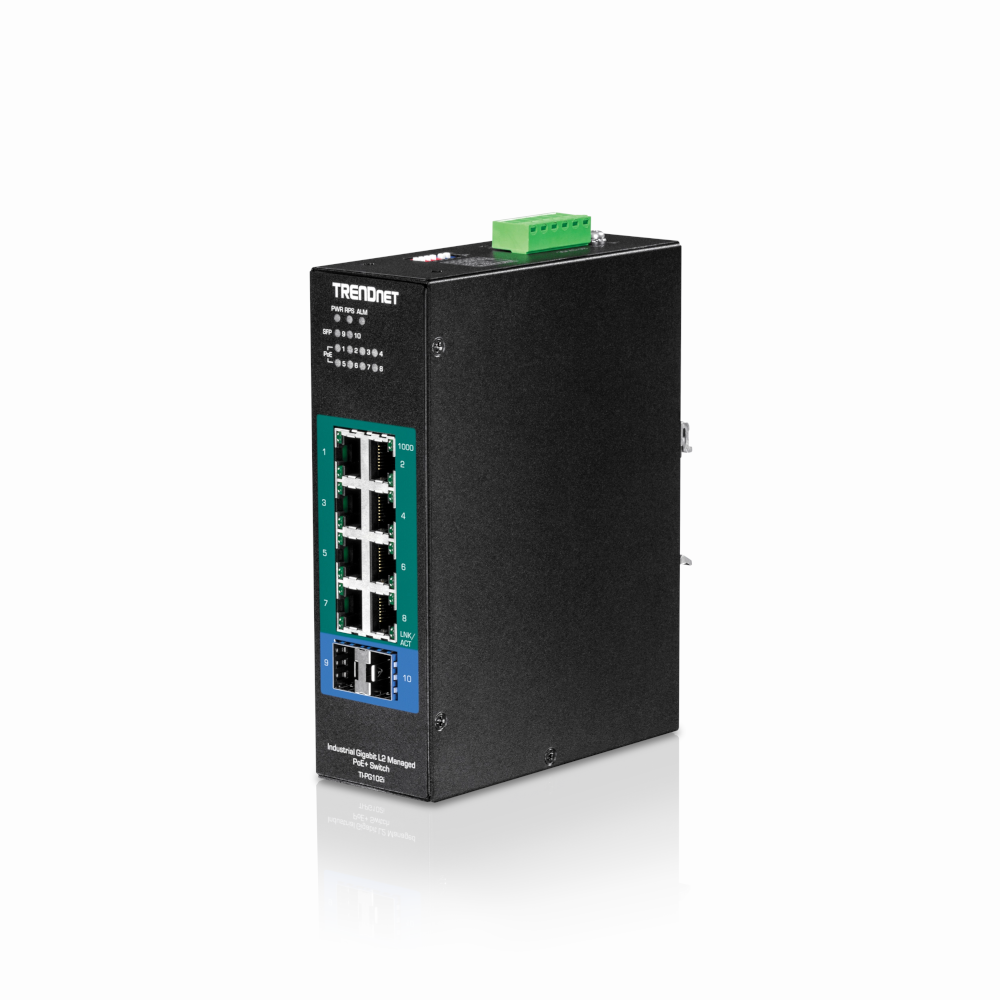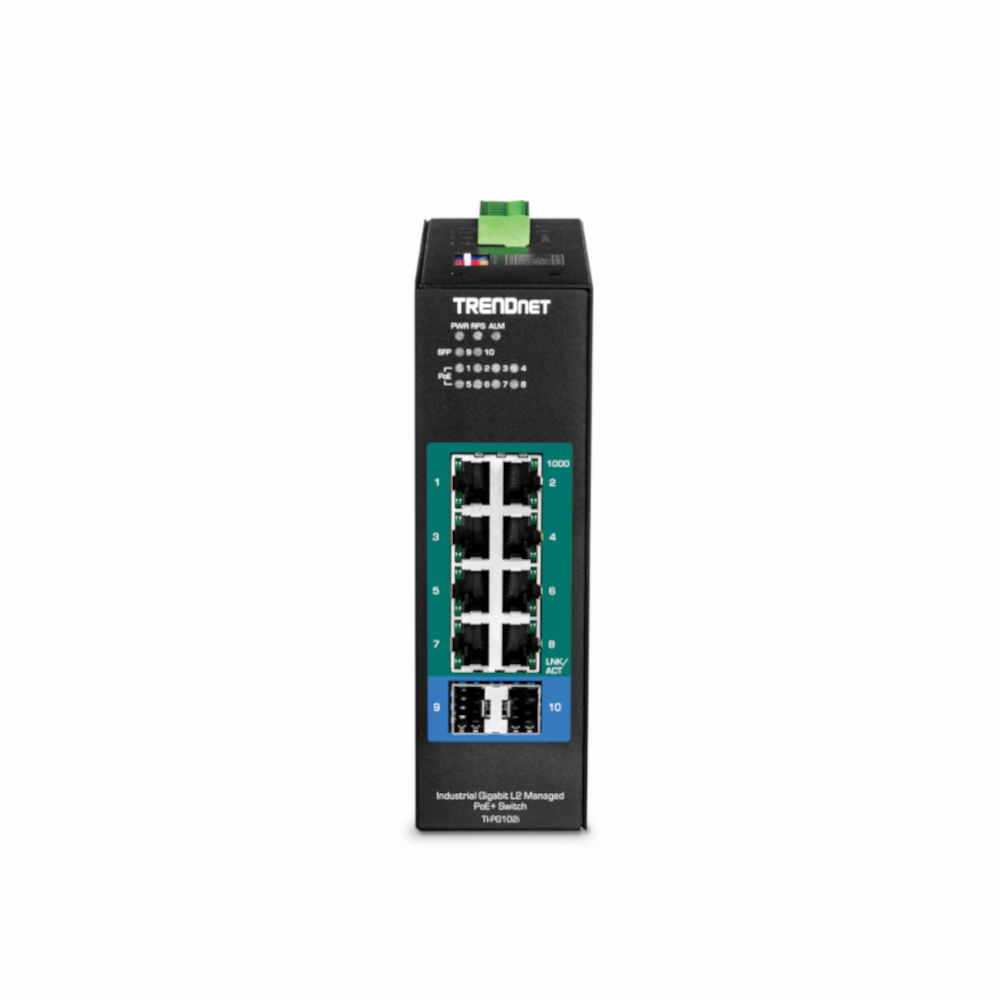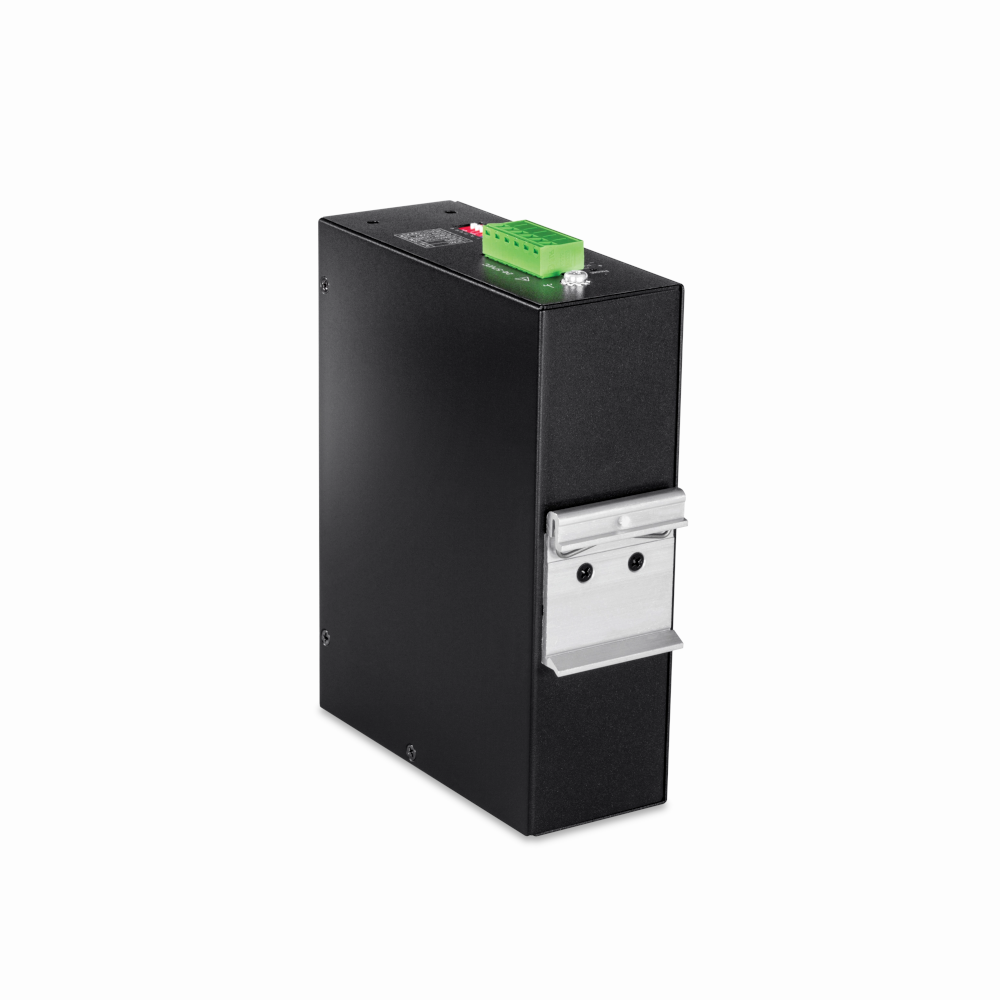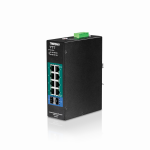TI-PG102i
- 8 x Gigabit PoE+ ports
- 2 x SFP slots
- Supports 100/1000Base-FX fiber SFP modules
- PoE power budget: 240W@48VDC or 124W@24VDC
- PoE alive check restarts unresponsive PoE powered devices
- 20Gbps switching capacity
- Hardened IP30 rated metal housing
- Includes DIN-rail mounting bracket
- Operating temperature range of -40° – 75° C (-40° – 167° F)
- Supports LACP, STP/RSTP, VLAN, and IGMP Snooping
- IEEE 802.1p QoS with queue scheduling support
- Bandwidth control per port
- Redundant power inputs with overload current protection
- Alarm output triggered by power failure
- Supports Ethernet Ring Protection Switching (ERPSv2)
- Power supply sold separately (models: TI-S24048, TI-S48048, TI-S12024)
| Specifications | |||
| Standards | IEEE 802.1d | ||
| IEEE 802.1p | |||
| IEEE 802.1Q | |||
| IEEE 802.1w | |||
| IEEE 802.1X | |||
| IEEE 802.1ab | |||
| IEEE 802.1ax | |||
| IEEE 802.3u | |||
| IEEE 802.3x | |||
| IEEE 802.3z | |||
| IEEE 802.3ab | |||
| IEEE 802.3ad | |||
| IEEE 802.3az | |||
| IEEE 802.3af | |||
| IEEE 802.3at | |||
| Device Interface | 8 x Gigabit PoE+ ports | ||
| 2 x 100/1000Mbps SFP slots | |||
| 6-pin removable terminal block (primary/RPS power inputs & alarm relay output) | |||
| DIP switches | |||
| LED indicators | |||
| Reset button | |||
| Data Transfer Rate | Ethernet: 10Mbps (half-duplex), 20Mbps (full-duplex) | ||
| Fast Ethernet: 100Mbps (half duplex), 200Mbps (full duplex) | |||
| Gigabit Ethernet: 2000Mbps (full duplex) | |||
| Performance | Switch fabric: 20Gbps | ||
| RAM buffer: 128MB | |||
| MAC address table: 8K entries | |||
| Jumbo frames: 10KB | |||
| Forwarding mode: store and forward | |||
| Forwarding rate: 14.88Mpps (64-byte packet size) | |||
| Management | HTTP web-based GUI | ||
| CLI: Telnet / SSHv2 | |||
| SNMP v1, v2c, v3 | |||
| SNMP trap (up to 5 receivers) | |||
| RMON groups 1/2/3/9 | |||
| Device configuration backup & restore, upgrade firmware, reboot, and reset to default | |||
| Multiple administrative or read-only user accounts | |||
| Enable or disable power saving mode per port | |||
| Static MAC entries | |||
| LLDP (Link layer discovery protocol) | |||
| Netlite device map | |||
| ONVIF device discovery | |||
| SNTP | |||
| SMTP alert | |||
| Syslog | |||
| Port statistics/utilization | |||
| Traffic monitor | |||
| Port mirror: one to one, many to one | |||
| Storm control: Broadcast, multicast, destination lookup failure (Min. limit: 1pps) | |||
| Loopback detection | |||
| DHCP relay/option 82 | |||
| Modbus/TCP | |||
| SFP DDMI (Digital Diagnostic Monitoring Interface) | |||
| ERPS (Ethernet Ring Protection Switching) G8032v2 | |||
| MIB | MIB II RFC 1213 | ||
| Bridge MIB RFC 1493 | |||
| RMON (Group 1,2,3,9) RFC 2819 RFC 1757 | |||
| Spanning Tree | IEEE 802.1d STP (spanning tree protocol) | ||
| IEEE 802.1w RSTP (rapid spanning tree protocol) | |||
| BPDU filter, guard, and root guard | |||
| Link Aggregation | Static link aggregation and 802.3ad dynamic LACP (Up to 3 groups) | ||
| Quality of Service (QoS) | 802.1p Class of service (CoS) | ||
| DSCP (Differentiated Services Code Point) | |||
| Bandwidth control per port | |||
| Queue Scheduling: strict priority (SP), weighted round robin (WRR), weighted fair queuing (WFQ) | |||
| VLAN | 802.1Q tagged VLAN | ||
| MAC-based VLAN | |||
| Port isolation | |||
| Up to 256 VLAN groups, ID range 1-4094 | |||
| Multicast | IGMP snooping v1, v2, v3 | ||
| IGMP querier | |||
| IGMP fast leave | |||
| Up to 256 multicast groups | |||
| Static multicast entries | |||
| Access Control | 802.1X authentication (Local user database, RADIUS, guest VLAN assignment) | ||
| DHCP snooping/screening | |||
| Trusted host/IP access list for management access | |||
| Port Security/MAC address learning restriction (Up to 100 entries per port) | |||
| Static/dynamic ARP inspection | |||
| ACL | Source/Destination MAC address | ||
| Source/Destination IP address | |||
| Source Interface | |||
| VLAN ID | |||
| EtherType | |||
| TCP/UDP port 1-65535 | |||
| Special Features | Netlite device discovery and map display in GUI | ||
| Port security: MAC address learning restriction per port | |||
| DHCP relay/option 82 & DHCP server snooping/screening support | |||
| Wide operating temperature range | |||
| Redundant power inputs | |||
| Alarm relay triggered by power failure | |||
| Surge and ESD protection | |||
| Power | PWR (Primary) terminal input: 24 – 57V DC | ||
| RPS (Redundant) terminal input: 24 – 57V DC | |||
| Compatible power supply: TI-S12024 (120W), TI-S24048 (240W), TI-S48048 (480W) sold separately | |||
| Max. Consumption: 13W (no PoE load), 253W (full PoE load) | |||
| PoE | PoE budget: 240W@48V DC input, 124W@24V DC input | ||
| 802.3at: Up to 30W per port | |||
| PoE Mode A: Pins 1, 2, 3, and 6 for power | |||
| PoE auto classification | |||
| PoE port priority/power scheduling/PD alive check | |||
| Over current/short circuit protection | |||
| Terminal Block | Redundant power inputs, alarm relay contact, 6 pin | ||
| Wire range: 0.5 mm^2 to 2.5 mm^2 | |||
| Solid wire (AWG): 12-26 | |||
| Stranded wire (AWG): 12-26 | |||
| Wire strip length: 10-11mm | |||
| Dip Switch | Switch | Status | Function |
| 1 | OFF | Disable alarm relay for PWR power input | |
| ON | Enable alarm relay for power failure on PWR power input | ||
| 2 | OFF | Disable alarm relay for RPS power input | |
| ON | Enable alarm relay for power failure on RPS power input | ||
| 3 | OFF | Storm control managed by switch configuration | |
| ON | Enable storm control (Broadcast and DLF rate set to 300pps) | ||
| Takes precedence over storm control switch configuration | |||
| 4 | OFF | 802.1p QoS managed by switch configuration | |
| ON | Enable 802.1p QoS on ports 1 and 2 (Set CoS priority to tag 4 on ports 1 and 2) | ||
| Takes precedence over 802.1p QoS switch configuration | |||
| 5 | OFF | Port 9 SFP set to Gigabit speed full duplex | |
| ON | Port 9 SFP set to 100Mbps speed full duplex | ||
| 6 | OFF | Port 10 SFP set to Gigabit speed full duplex | |
| ON | Port 10 SFP set to 100Mbps speed full duplex | ||










